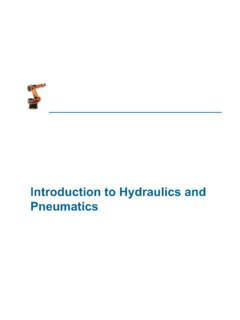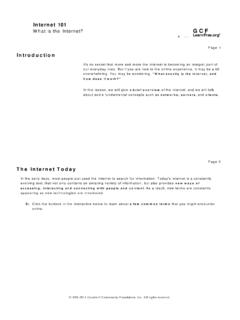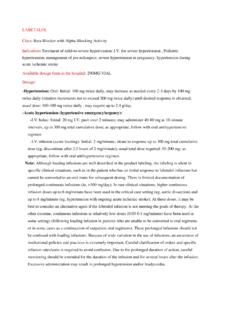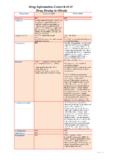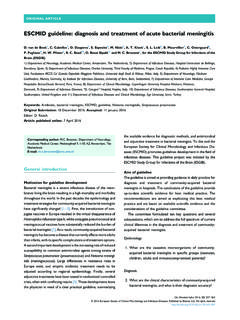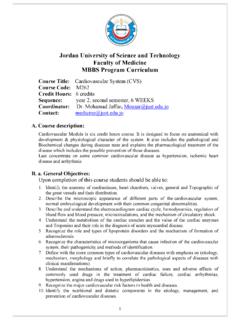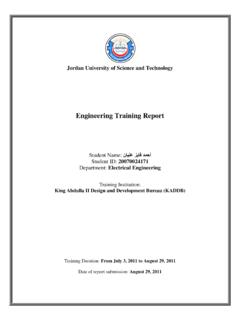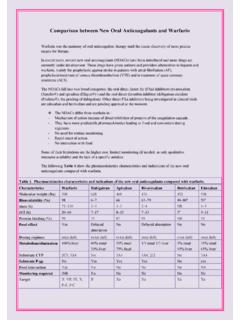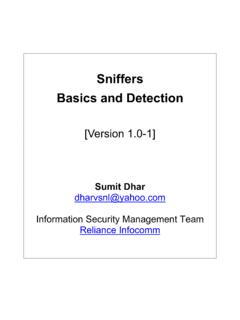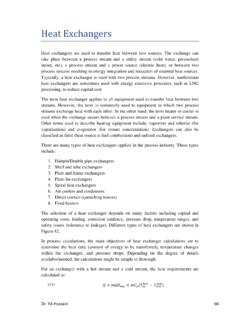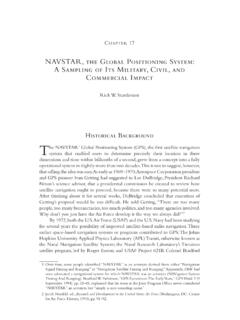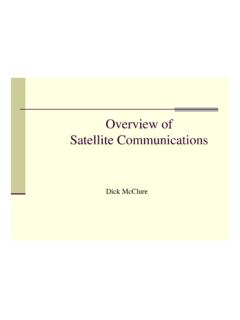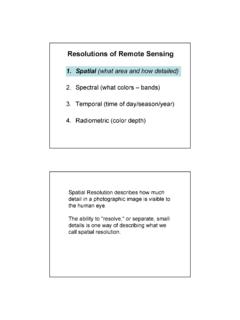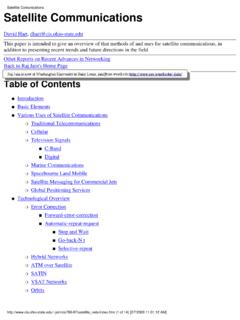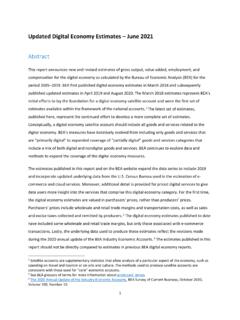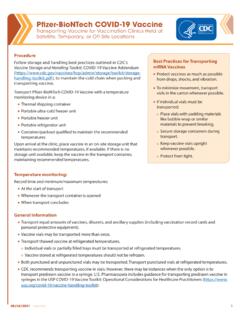Transcription of Satellite Space Link Link-power Budget
1 Satellite Space LinkSatellite Space LinkLinkLink--power Budgetpower BudgetSatellite system ParametersSatellite system Parameters11. Effective Isotropic Radiated Power (EIRP). Effective Isotropic Radiated Power (EIRP) A key parameter in link Budget is the A key parameter in link Budget is the equivalent/Effective isotropic radiated power:equivalent/Effective isotropic radiated power:[EIRP]=[Ps]+[G] dBW[EIRP]=[Ps]+[G] dBW[Ps][Ps]--the power at the antenna input (dBW)the power at the antenna input (dBW)[G] [G] Antenna Gain (dB)Antenna Gain (dB) Satellite system ParametersSatellite system Parameters11. Effective Isotropic Radiated Power (EIRP). Effective Isotropic Radiated Power (EIRP) For Parabolic Antennas with efficiency For Parabolic Antennas with efficiency == 73 , the gain can be approximated by:, the gain can be approximated by:G=G= (( 472 ffD)D)22 Where Where ff the operating frequency in GHzthe operating frequency in GHzD D Ant.
2 Diameter in mAnt. Diameter in mEIRP ExampleEIRP ExampleA Sat. downlink at A Sat. downlink at 12 12 GHz operates with a transmit GHz operates with a transmit power (Pt) of power (Pt) of 66W and an antenna diameter of W and an antenna diameter of 3 3 m m and efficiency and efficiency Calculate EIRP. Calculate (( )fD)22== (x( ))22== [G]=[G]=10 10 Log(Log( )=)= 9 dBdB[EIRP]=[EIRP]=1010loglog66++ = 7 dBWdBWSatellite system ParametersSatellite system Parameters22. Free Space Path Loss (Lp). Free Space Path Loss (Lp) Lp is the loss incurred by an electromagnetic Lp is the loss incurred by an electromagnetic wave as it propagates in a straight line through wave as it propagates in a straight line through vacuum with no absorption or reflection of vacuum with no absorption or reflection of energy from nearby objectsenergy from nearby objects Lp is frequency dependent (wavelength Lp is frequency dependent (wavelength ) ) and increases with distance and increases with distance r r ::22P44L crfr Satellite system ParametersSatellite system Parameters cfrLogcfrLog 420410]L[2P rLogfLogcLog2020420]L[P Lp in dB:Lp in dB: With With c=c=33xx10108 8 m/sm/s, , f f in GHz and in GHz and rrin Km, Lp in Km, Lp in dB:in dB.
3 ]L[P EIRP ExampleEIRP ExampleFind Lp for an uplink operating at Find Lp for an uplink operating at 6 6 GHz with a GHz with a distance r=distance r=4200042000Km. If the ES EIRP is Km. If the ES EIRP is 120 120 dBW, dBW, what will be the RX power in will be the RX power in [Lp]=[Lp]= + + 20 20 Log (Log (4200042000) + ) + 20 20 Log(Log(66))[Lp]=[Lp]= 4 dBdB[P[PRXRX]=]= 4 dBW=dBW= 4 dBmdBmSatellite system ParametersSatellite system Parameters33. Additional Atmospheric and Ionospheric . Additional Atmospheric and Ionospheric Losses (Lu/Ld)Losses (Lu/Ld)Atmospheric gases result in losses by absorption. Atmospheric gases result in losses by absorption. These losses usually amount to a fraction of a These losses usually amount to a fraction of a dB[AA].
4 DB[AA]. Also, the ionosphere introduces a depolarization Also, the ionosphere introduces a depolarization loss [PL]loss [PL] Satellite system ParametersSatellite system Parameters44. Feeder and Branching Losses (L. Feeder and Branching Losses (Lbfbf))Losses will occur in the connection between Losses will occur in the connection between waveguides, filters couplers and Branching units waveguides, filters couplers and Branching units 55. Antenna Misalignment Losses (AML) . Antenna Misalignment Losses (AML) Loss that occurs as a result of having the ES and Sat. Loss that occurs as a result of having the ES and Sat. antennas being offantennas being off--axis. For ES, this loss is called axis. For ES, this loss is called antenna pointing loss. antenna pointing loss.
5 Loss that occurs as a result of having polarization Loss that occurs as a result of having polarization misalignmentmisalignment66. Polarization Misalignment Losses (PL) . Polarization Misalignment Losses (PL) Antenna MisalignmentsAntenna MisalignmentsExample: TelSat Canada DesignExample: TelSat Canada DesignSatellite system ParametersSatellite system Parameters77. Back. Back--off Loss (Loff Loss (Lbobo=[BO]=[BO]ii/[BO]/[BO]oo))HPAs used in ES HPAs used in ES transmitters and transmitters and TWTs used in Sat. TWTs used in Sat. transponders are transponders are nonlinear devices: nonlinear devices: their gain (outputtheir gain (output--input) is input) is dependent on the dependent on the input signal. input signal. Satellite system NoiseSatellite system NoiseThe RX power in a Sat.
6 Link is very small (couples of The RX power in a Sat. link is very small (couples of pW)pW) amplification can be used to bring the signal amplification can be used to bring the signal strength up to an acceptable up to an acceptable main source of noise is the random thermal The main source of noise is the random thermal motion of electrons + thermalmotion of electrons + thermal--like noise from like noise from antenna radiationantenna radiationThe total noise power can be :The total noise power can be :NNBKTP NKK--Boltzmans const. = Boltzmans const. = of the environment (K)temperature of the environment (K)BBNN--Noise Bandwidth (Hz)Noise Bandwidth (Hz) Satellite system NoiseSatellite system Noisee2e110,2KT)T(N antTKGA nother parameter is the noise factor F:Another parameter is the noise factor F:TeTe--Equivalent noise temperature (K)Equivalent noise temperature (K)The Noise Figure NF is:The Noise Figure NF is:Log(F)10[NF] For a cascaded amplifier:For a cascaded amplifier:TT1Fe 1)T(FTe )Log(T10][Tee Satellite system NoiseSatellite system Noisee2e110,2KT)T(N antTKGIn general, for a cascaded system N is:In general, for a cascaded system N is:TeTe--Equivalent noise temperature (K)Equivalent noise temperature (K)The Noise Figure NF is:The Noise Figure NF is:Log(F)10[NF] For a cascaded amplifier:For a cascaded amplifier.
7 GGTGTTTT21e31e2e1ants Noise ExampleNoise ExampleAn Ant. Has a noise temperature of An Ant. Has a noise temperature of 35 35 K and is K and is matched into a receiver which has a noise matched into a receiver which has a noise temperature of temperature of 100100K. Calculate the noise density K. Calculate the noise density and the noise power with a BW=and the noise power with a BW= (No=KT= (3535++100100)x) 067 pWpWNoise ExampleNoise ExampleConvert NF of Convert NF of 4 4 & & 1 dB to Te with K=dB to Te with K= [NF]=[NF]=4 4 dB dB F=F= [NF]=[NF]= 1 F=F= (( )=)= 6 KKTe=Te=300300(( )=)=471 471 KKNote that a Note that a 1 dBdBdifference in [NF] led to a difference in [NF] led to a in Tedifference in TeAntenna NoiseAntenna Noise RX antennas (ES and Sat.)
8 Introduce noise into the RX antennas (ES and Sat.) introduce noise into the system !!!! system !!!! Antenna Noise is also dependent on the angle Antenna Noise is also dependent on the angle of elevationof elevation Types: Types: 11) Self Antenna Noise) Self Antenna Noise22) Sky Noise) Sky Noise Typical Example: Typical Example: 11--ES Large CES Large C--band = band = 60 60 KK22--ES Ku (clear sky)= ES Ku (clear sky)= 80 80 K K 33--Sat. ant. = Sat. ant. = 290 290 K (Why High?!)K (Why High?!)Antenna NoiseAntenna NoiseAntenna NoiseAntenna NoiseRain FadingRain Fading Rain attenuation is more Rain attenuation is more serious at higher frequencies serious at higher frequencies (C, Ku, Ka,..)(C, Ku, Ka,..) Rain Information are Rain Information are available in the forms of available in the forms of curves and tablescurves and tablesRain FadingRain Fading The Effective Noise Temperature of Rain:The Effective Noise Temperature of Rain: The Total SkyThe Total Sky--noise Temperature: noise Temperature: rainCSskyTTT A1-1 TTarainAA--Rain attenuationRain attenuationTaTa--Apparent absorber temperatureApparent absorber temperatureExampleExampleUnder clear sky conditions, [C/N] is Under clear sky conditions, [C/N] is 20 20 dB, the dB, the total effective noise is total effective noise is 400400K.
9 If rain attenuation K. If rain attenuation exceeds exceeds 9 dB for dB for 1 % of the time, then % of the time, then calculate the value below which [C/N] falls for calculate the value below which [C/N] falls for given Ta=% given Ta= :Sol. ((11--11 )=)= 2 KKTs=[Ts=[ ]]--[[400400]=]= 96 dBdB[C/N]=[C/N]= 14 dBdBSatellite system ParametersSatellite system 88. Transmit Power (Pt) and Bit Energy (Eb). Transmit Power (Pt) and Bit Energy (Eb) The Energy per bit (EThe Energy per bit (Ebb) having P) having Pttat saturation at saturation and bit duration of Tand bit duration of Tbb::btbfPE In terms of the bit rate fIn terms of the bit rate fbb==11/T/Tbb, E, Eb b is:is: Satellite system ParametersSatellite system Parameters[No][C]]NC[KTCNCoo 99. Carrier. Carrier--toto--Noise Density Ratio (C/No)Noise Density Ratio (C/No) C/No is the average wideband carrier powerC/No is the average wideband carrier power--toto--noise density ratio:noise density ratio:]fB[]NC[]NE[NfCBBNfCNEbobbbbob 1010.
10 Bit Energy. Bit Energy--toto--Noise Density Ratio Noise Density Ratio (E(Ebb/N/Noo)) EEbb/No is a convenient method to compare /No is a convenient method to compare digital systems using different mod. Schemes!:digital systems using different mod. Schemes!: Satellite system ParametersSatellite system ParameterseLNAanteTGGTG 1111. Gain. Gain--toto--Equivalent Noise Temperature Equivalent Noise Temperature Ratio (G/Te)Ratio (G/Te) G/Te is a figure of merit used to represent an G/Te is a figure of merit used to represent an ES or Sat. RX:ES or Sat. RX:For a transponder GFor a transponder Gantant==12 12 dB, GdB, GLNALNA==10 10 dB and Te=dB and Te=26 26 dBK, then its G/Te figure of merit:dBK, then its G/Te figure of merit:][T-][G][G]TG[eLNAantdB/Ke G/Te=G/Te=1212++1010--2626==--4 4 dBKdBK--11 Satellite UpLink EquationSatellite UpLink EquationHPAHPAPt +Pt +LLboboLLbbLNALNALbLbG/ , L, Luu, AML,PL, AML,PLGG antantGGsantsantLLsfsfesatbobfLNAsantupE SbobfinantKTLLGGLLLLPG).
